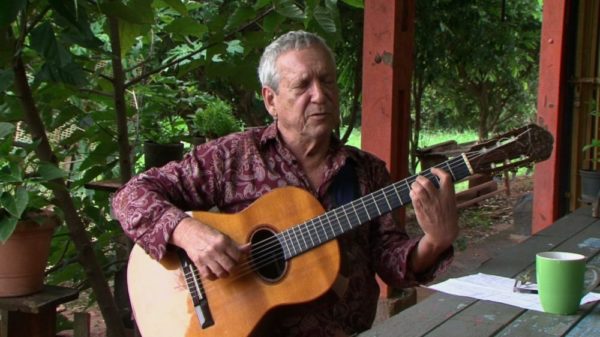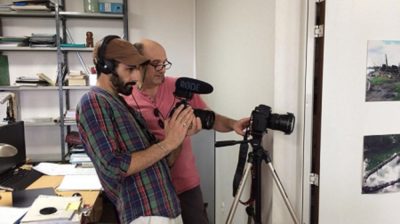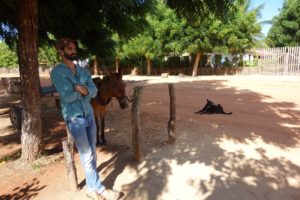Director Statement
DIRECTOR STATEMENT
LOVELY WORKING FOR THE NEW MOONLIGHT

DIRECTOR STATEMENT
TRABAJAR BONITO PARA EL NUEVO CLARO DE LUNA

Director Statement : Hugo Dayan
Researcher at French National Center for Scientific Research (CNRS) working on topics related to local capacity (social, economic, environmental and cultural) to adapt to climate change impacts …
… Yes I’m a researcher… but heavily influenced by the art of cinematography and the aesthetics of the transmission of knowledge. My viewpoint is therefore twofold: the one of a young scientist trying to fulfill himself as a researcher, as much as a film director considering that knowledge sharing and emotion are inseparable.
My interest for the 7th art started to rise especially during my field research missions (2012-2015), including several short films, within the cartographic framework of the “Economía Solidaria Sustentable en America del Sur” (ESSAS) program. This program is at the origin of making this film and provided conceptual and factual data used to make it (https://apreis.eu/essas/esp/).
It dealt with local sustainable creative initiatives in South America – the spontaneous local popular economy – in the fields of tourism, waste treatment, agriculture, education, small-scale trade, micro finance, local complementary currency, crafts and arts, an economy often led by women in South America. The research was conducted by the scientific, artistic and cultural laboratory, APREIS, the independent and non-profit producer of this film.
My first intention was to explore a new aesthetics of knowledge and of its sharing, an aesthetics able to highlight the artistic and sensible faces of life and their nuances. The result is a film that reaches far beyond the usual borders between documentary and fiction and leads to an aesthetics policy, more interactive, and a policy aesthetics, more constructive. Aesthetics that broaden the public space, the space we have in common, a universal and contextualized scene conducive to human contacts, to emotions sharing and to discoveries which enables the viewing public to react as « spect-actors » : the very intention of the cinema making people opens the eyes and raises the head.
The film tells the story of the creation of a song by a musician, role played by the Brazilian composer Geraldo Espindola (as himself), who places particular emphasis on the nature, the feminine sensibility and the hopes of those who pay attention to the human values. He would like to present it at the occasion of a concert for the World Environment Day in the Brazilian capital of the Pantanal, Corumbá, bordering Bolivia.
In search of inspiration, he undertakes a trip to Brazil and Bolivia to write this song from the village of Trancoso – bordered by the Atlantic and located on the Discovery Coast where the first “conquerors” arrived in Brazilian lands – to the small village of Marawa, in Bolivia – surrounded by the Andean mountains which are crossed by the “Camino Inca” – to the Pantanal – the largest wetland on the plane – where the composer resides and where Corumbá is located.

The cameras follow his encounters and linger on the creativity of local popular cultures who he discovers. The story intersects and intertwines the three major characters of the film:
-the actors of local experiences the musician meets
– the landscapes as experienced as the artist walk through it and look upon it, full of movement and feeling
– the artist who takes to heart to write the song lyrics and melody that should allow him to pay homage at a concert in Corumbá to the women and men who are inspiring his song, including the outstanding natural or cultural sites where they live, work and create.
Mixing artistic creation, social creativity and scenic beauties, which are distinct yet inseparable, the title of the song, “Trabajar bonito para el nuevo claro de luna” is the meaning of the word “development” in Quechua, after whom this film was named.
When all the characters play their own role in a film about artistic and social creation in using their simple and deep words to describe their humble and powerful experiences, the images gain in authenticity and depth of life. It is a spectacle of the life art which is filmed. “Trabajar bonito” shows the intimacy of dreams and hopes but also doubts and sorrows of those who seek and build sustainable paths of life. In giving, notably, real life, sincerity and truth to a story, the “cre-actors” emotionally touches the general audience, while also inspiring through their smiles a quiet sense of wonder and dream
This kind of cinematographic narrative, including notably emotions experienced, provides a sensible and reflexive story of reality while based on sound knowledge but, within a sensitive, ludic and attractive framework, clear to be grasped by everyone because of a narrative way that is unique to the music. Through the artist’s sensibility and the trip that he offers to spectators, the narrative makes the invisible more visible. Such a story clarifies what all these characters have in common without knowing each other. As the composition of the musician progresses, the links that unite the different human experiences take on their importance. This importance reaches its peak and will be immediately evidenced to the spectators in the unexpected yet logical manner with which the concert is cinematically treated.
By linking artistic creation and cultural creativity, this film stages the story – both reality and fiction – of an encounter between the artist imaginary and the social life working.
In the end, this feature film is a documentary on the social creativity and a narrative fiction on the musical creation and on the imaginary of sustainability in local popular cultures and, among them, especially that of women. Sustainability is a feminine concept in South America.





